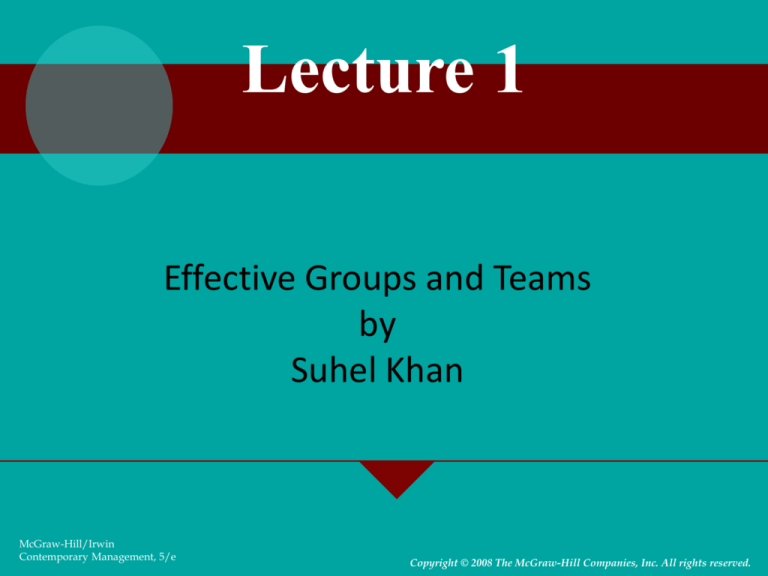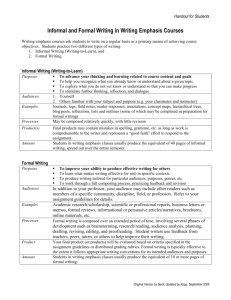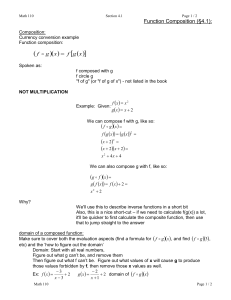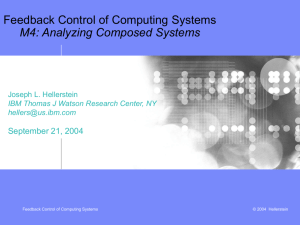
Lecture 1
Effective Groups and Teams
by
Suhel Khan
McGraw-Hill/Irwin
Contemporary Management, 5/e
Copyright © 2008 The McGraw-Hill Companies, Inc. All rights reserved.
Learning Objectives
• Explain why groups and teams are key
contributors to organizational effectiveness.
• Identify the different types of groups and
teams that help managers and organizations
achieve their goals.
• Explain how different elements of group
dynamics influence the functioning and
effectiveness of groups and teams.
15-2
Learning Objectives
• Explain why it is important for groups and
teams to have a balance of conformity and
deviance and a moderate level of
cohesiveness.
• Describe how managers can motivate group
members to achieve organizational goals
and reduce social loafing in groups and
teams.
15-3
Groups, Teams and
Organizational Effectiveness
• Group
– Two or more people
who interact with each
other to accomplish
certain goals or meet
certain needs.
15-4
Groups, Teams and
Organizational Effectiveness
• Team
– A group whose members work intensely with
each other to achieve a specific, common goal
or objective.
– All teams are groups but not all groups are
teams.
• Teams often are difficult to form.
• It takes time for members to learn how to work
together.
15-5
Groups, Teams and
Organizational Effectiveness
• Two characteristics distinguish teams from
groups
– Intensity with which team members work
together
– Presence of a specific, overriding team goal or
objective
15-6
Groups and Teams as
Performance Enhancers
• Advantage of synergy
– People working in a group are able to produce
more outputs than would have been produced if
each person had worked separately
15-7
Groups and Teams as
Performance Enhancers
• Factors that contribute to synergy
– Ability of group members to bounce ideas off one
another
– To correct one another’s mistakes
– To bring a diverse knowledge base to bear on a
problem
– To accomplish work that is too vast for any one
individual to achieve
15-8
Groups and Teams as
Performance Enhancers
• To take advantage of the potential for synergy,
managers need to make sure groups are
composed of members who have
complementary
skills and knowledge
relevant to the
group’s work
15-9
Groups’ and Teams’ Contributions to
Organizational Effectiveness
Figure 15.1
15-10
Groups and Teams and
Responsiveness to Customers
• Responsiveness to Customers
– Difficult to achieve given the many constraints.
• Safety issues, regulations, costs.
– Cross-functional teams can provide the wide
variety of skills needed to meet customer
demands.
• Teams consist of members of different departments.
15-11
Teams and Innovation
• Innovation
– The creative development of new products, new
technologies, new services, or new
organizational structures
• Individuals rarely possess the wide variety of skills
needed for successful innovation.
• Team members can uncover each other’s flaws and
balance each other’s strengths and weaknesses
• Managers should empower the team and make it
accountable for the innovation process.
15-12
Groups and Teams as Motivators
• Members of groups, and particularly teams,
are often better motivated and satisfied than
individuals.
– Team members are more motivated and satisfied
than if they were working alone.
– Team members can see the effect of their
contribution to achieving team and
organizational goals.
– Teams provide needed social interaction and help
employees cope with work-related stressors.
15-13
The Types of Groups and Teams in Organizations
Figure 15.2
15-14
Question?
Which type of group is one that managers
establish to achieve organization goals?
A. Formal group
B. Informal group
C. Virtual team
D. Interest group
15-15
The Types of Groups and Teams
• Formal Group
– A group that managers establish to achieve
organization goals.
15-16
Formal Groups
• Cross-functional teams
– composed of members from different
departments
• Cross-cultural teams
– composed of members from different cultures or
countries
15-17
The Types of Groups and Teams
• Informal Group
– A group that managers or nonmanagerial
employees form to help achieve their own goals
or to meet their own needs.
15-18
The Types of Groups and Teams
Type of Team
Top-management
team
A group composed of the CEO, the president,
and the heads of the most important
departments
Research and
development team
A team whose members have the expertise
and experience needed to develop new
products
Command groups
A group composed of subordinates who
report to the same supervisor, also called a
department or unit,
Task forces
A committee of managers or nonmanagerial
employees from various departments or
divisions who meet to solve a specific,
mutual problem; also called an “ad hoc”
committee
15-19
The Types of Groups and Teams
Type of Team
Self-managed work
team
A group of employees who supervise their
own activities and monitor the quality of the
goods and services they provide.
Virtual team
A team whose members rarely or never meet
face to face and interact by using various
forms of information technology such as
email, computer networks, telephone, fax and
video conferences.
Friendship group
An informal group composed of employees
who enjoy each other’s company and
socialize with each other.
Interest group
An informal group composed of employees
seeking to achieve a common goal related to
their membership in an organization.
15-20
Self-Managed Work Teams
Keys to effective self managed teams:
– Give the team enough responsibility and
autonomy to be self-managing.
– The team’s task should be complex enough to
include many different steps.
– Select members carefully for their diversity, skills,
and enthusiasm.
– Managers should guide and coach, not supervise.
– Determine training needs and be sure it is
provided.
15-21
Virtual Teams
• A team whose members rarely meet face-toface
• Interact by using various forms of
information technology
• Email, computer networks, telephone, fax,
and videoconferences
15-22
Friendship Groups
An informal group composed of employees
who enjoy one another’s company and
socialize with
one another
15-23
Interest Groups
An informal group of employees seeking to
achieve a common goal related to their
membership in an organization
15-24
Group Size
• Advantage of small groups
– Interact more with each other and easier to
coordinate their efforts
– More motivated, satisfied, and committed
– Easier to share information
– Better able to see the importance of their
personal contributions
15-25
Group Size
• Advantages of large groups
– More resources at their disposal to achieve group
goals
– Enables managers to obtain division of labor
advantages
15-26
Group Size
• Disadvantages of large groups
– Problem of communication and coordination
– Lower level of motivation
– Members might not think their efforts are really
needed
15-27
Group Tasks
• Group tasks impact how a group interacts.
– Task interdependence shows how the work of one
member impacts another; as interdependence
rises, members must work more closely together.
15-28








